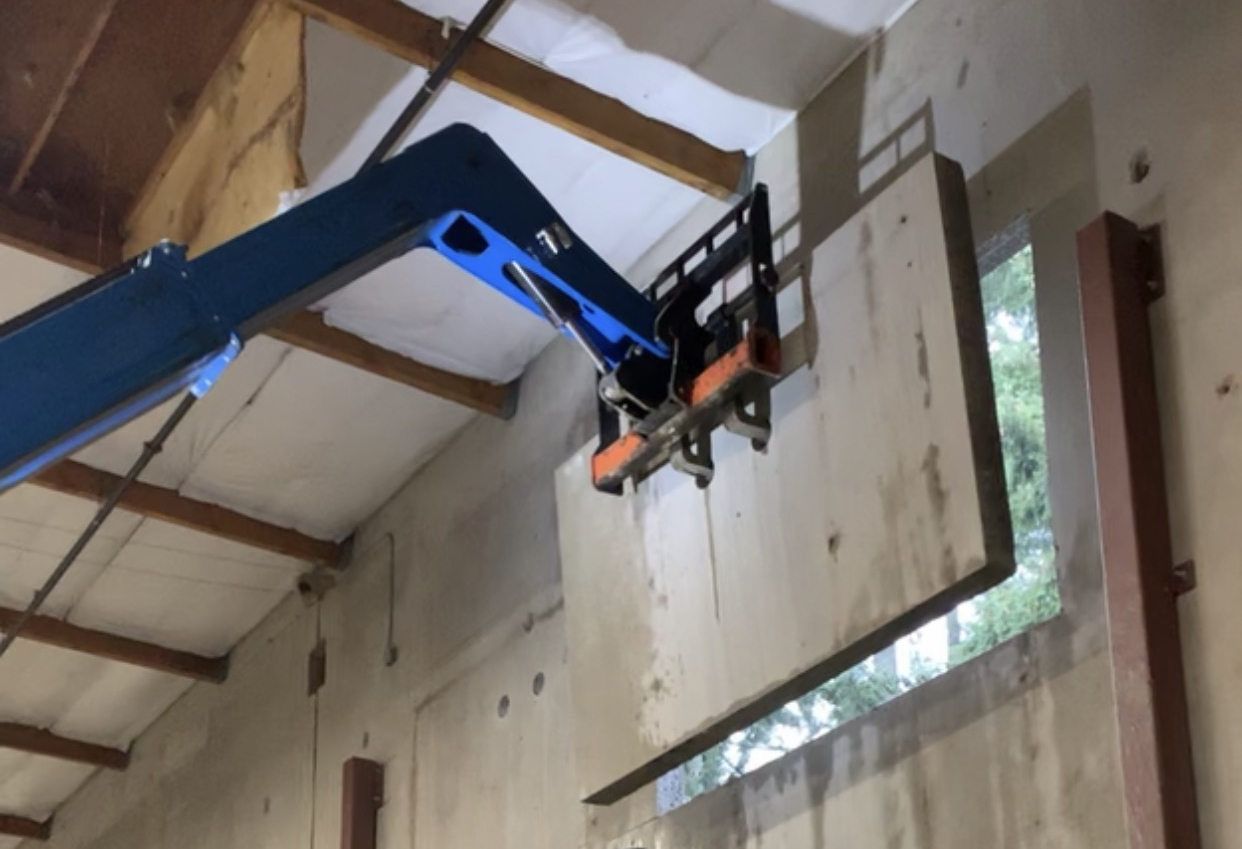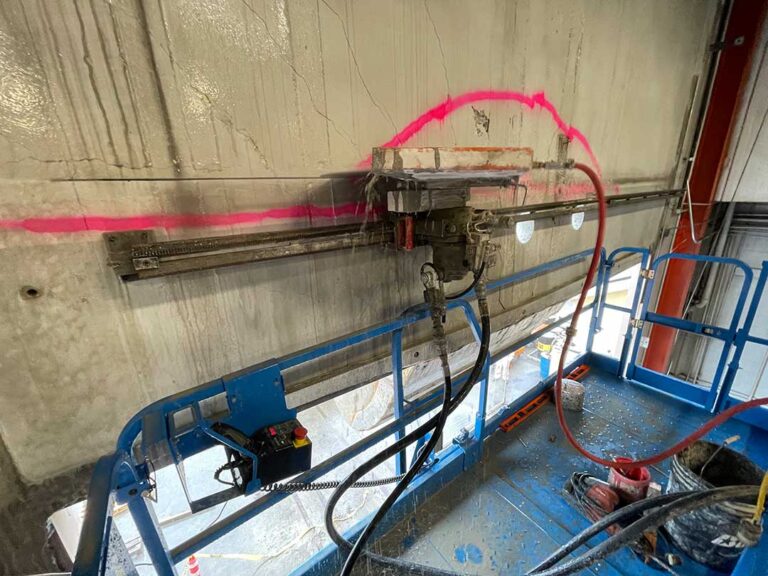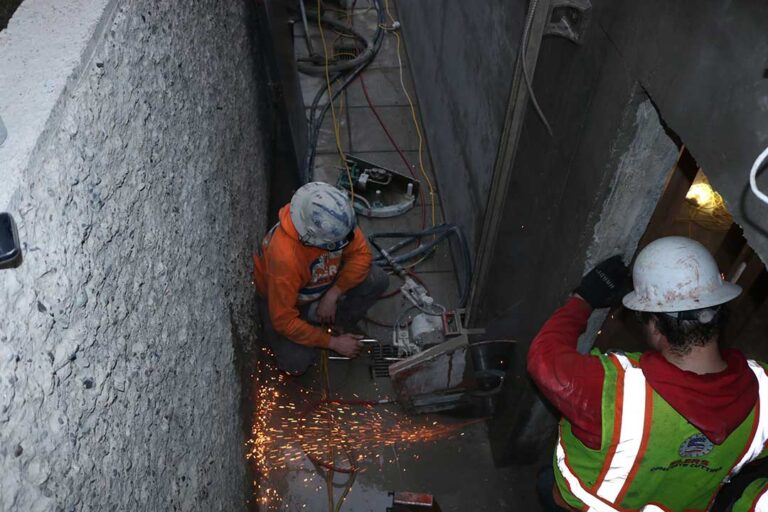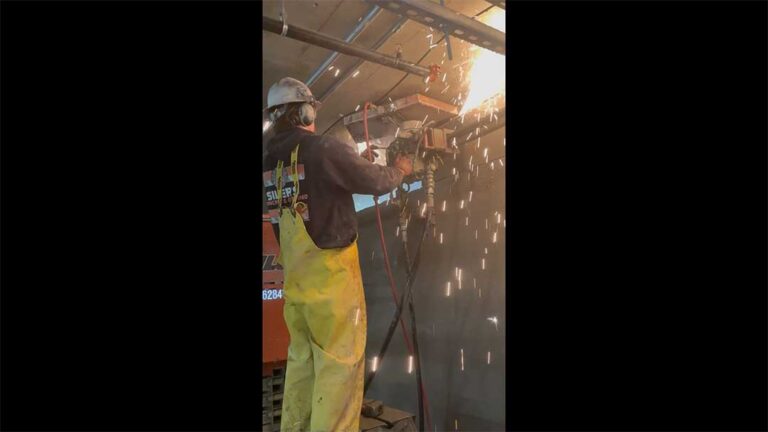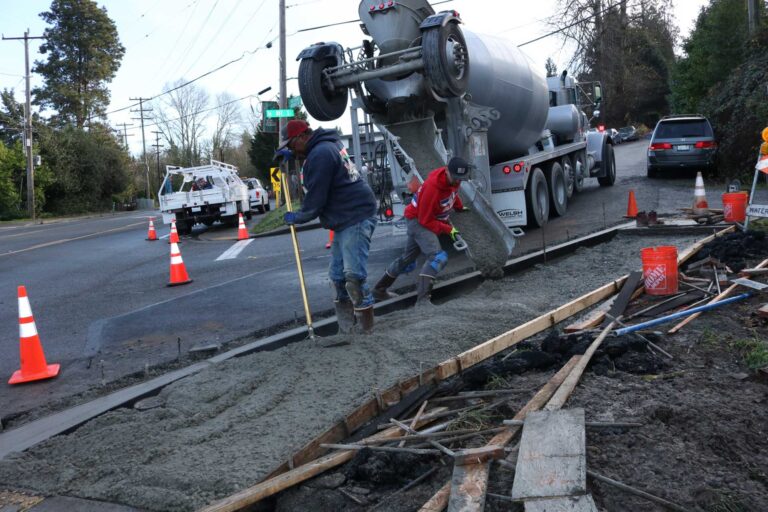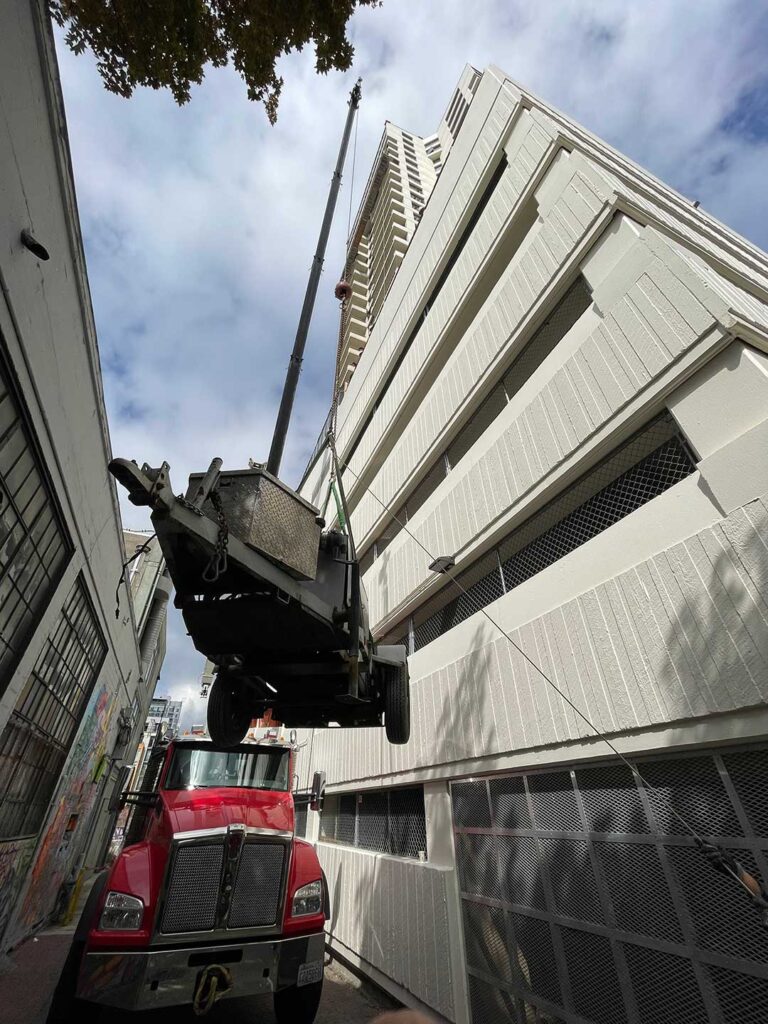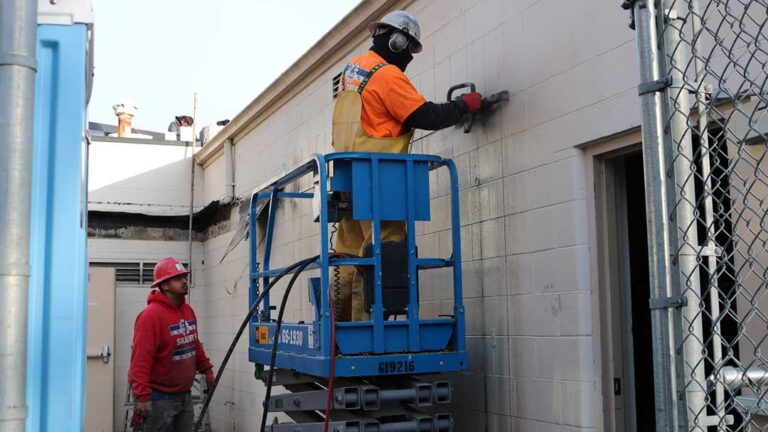Concrete Wall Sawing: Expert Techniques and Best Practices
Concrete wall sawing is an essential technique in the construction and renovation industry for cutting a variety of materials like concrete, reinforced concrete, stone, asphalt, and cinder block. This method allows construction professionals to make precise cuts on vertical or sloped surfaces, ensuring a high level of accuracy and efficiency in their projects. Wall sawing is commonly employed for creating doors, windows, and ventilation openings, as well as for demolition and structural modifications.
A concrete wall saw, also referred to as a track saw, is a specialized piece of equipment that typically uses a circular diamond blade mounted on a track-guided system. This design provides excellent control and stability during the cutting process, allowing for the creation of straight and bevel cuts even in challenging conditions. The use of diamond blades ensures fast and clean cuts with minimal vibration, which is crucial for safety and accuracy in construction projects.
With advancements in technology, wall sawing has become more efficient and versatile, offering a range of solutions for contractors and builders. A skilled operator can expertly maneuver the wall saw to create openings and cuts in confined spaces, on steep inclines, or in challenging materials like heavily reinforced concrete. As a result, concrete wall sawing has grown to be an indispensable method in the construction industry, meeting the ever-changing needs of modern projects.
Understanding Wall Sawing
Wall sawing is a specialized technique used for creating precise cuts in concrete walls and other vertical surfaces. Construction projects commonly employ it to create openings for new doorways, windows, or HVAC units. By using advanced equipment like concrete wall saws and track saws, this method allows for accurate and efficient cuts in various materials.
Concrete wall sawing is an innovative system that has brought significant improvements to the concrete cutting industry. Wall saws, also known as track saws, are typically powered by hydraulic or electric systems, ensuring high performance and precision. These saws take advantage of diamond blades mounted on a track system, which helps achieve consistent and smooth cuts on both concrete and masonry surfaces
The technique of wall sawing contributes several advantages to construction projects. First, it saves time and labor thanks to its precision and efficiency. By using powerful wall saws, workers can create any required opening in the walls without causing damage to the surrounding areas. Additionally, the dust and debris generated during the cutting process can be significantly reduced compared to other construction methods, providing a cleaner and safer work environment for all personnel involved.
Safety is a crucial aspect to consider during the wall sawing process. Skilled operators must exercise care and good judgment while handling high-powered tools to avoid accidents. It is essential to follow appropriate safety guidelines, including wearing the necessary personal protective equipment, setting up proper workspaces, and always being aware of one’s surroundings.
In summary, wall sawing is a valuable technique in construction projects that require precise cuts in concrete and masonry surfaces. Experts can ensure quick, accurate, and safe results by utilizing advanced equipment and adhering to strict safety measures. With its numerous benefits, concrete wall sawing has become indispensable for creating openings in walls, accommodating modern architectural designs, and ensuring the success of various construction endeavors.
Types of Wall Sawing
Electric Powered Wall Sawing
Electric powered wall sawing utilizes an electric motor to drive the diamond blade, which is mounted on a track system. This method is well-suited for cutting through concrete, stone, and masonry. The electric power allows for precise and even cuts, while also reducing noise and emissions on the job site. Being an eco-friendly option, electric powered wall sawing is often preferred in areas with strict environmental regulations.
Hydraulic Wall Sawing
Hydraulic wall sawing, as the name suggests, makes use of a hydraulic system to power the saw. This method enables a stronger cutting performance, which is ideal for working with heavily reinforced concrete and other tough materials. The hydraulic power also allows the wall saw to operate under challenging conditions, such as in submerged or underwater applications.
Wire Wall Sawing
Wire wall sawing employs a diamond-studded wire to cut through concrete and other dense materials. The wire saw is wrapped around the workpiece, and tension is applied to create a cutting motion. This technique is particularly useful for cutting irregularly shaped objects or creating complex openings in walls and slabs. Wire sawing is highly versatile and can cut through exceptionally thick sections of material.
Slab Sawing
Slab sawing, also known as flat sawing, utilizes a concrete saw or slab saw to make cuts into horizontal surfaces like floors, pavement, or bridge decks. This method is used when there is a need to create expansion joints, remove damaged sections of concrete, or install utilities beneath a slab’s surface. Slab sawing can be powered by electric, hydraulic, or even gas-powered engines, depending on the specific application and requirements.
Scope of Application
Concrete wall sawing is a crucial technique utilized in various construction projects involving walls, ceilings, floors, and other surfaces. This method is mainly used for cutting through concrete walls, providing precise and smooth-finished openings in different structures, including masonry and precast walls. With its accurate cutting capabilities, concrete wall sawing has become an indispensable tool for creating openings for doors, windows, and other fixtures in the construction industry.
In addition to creating openings in walls, concrete wall sawing can be employed for several other purposes. It can be used to achieve flush-cutting against adjoining wall surfaces, cutting chamfered edges, and accurately sized fixture-ready openings in key structural elements, such as foundations, dams, and levies. Its application is not limited to vertical surfaces alone, as it is equally efficient in creating precise openings in ceilings and floors. This method becomes particularly useful when dealing with reinforced concrete in commercial and residential construction projects.
Moreover, concrete wall sawing techniques are essential for refurbishing and demolishing existing structures. Safely cutting through vertical surfaces or floors without causing damage to the surrounding materials is one of the major benefits of this method. Highly versatile in its approach, concrete wall sawing can be implemented using various types of saws, such as hand-held, chop-saw, or walk-behind saws, depending on the specific project requirements.
In conclusion, the scope of application for concrete wall sawing is wide-ranging, spanning across different construction materials and project types. It efficiently caters to commercial and residential construction needs, allowing for precise cuttings in concrete walls, ceilings, floors, and masonry structures. The versatility and accuracy of this technique make it a valuable asset in the construction industry, ensuring that project requirements are met with precision and efficiency.
Wall Sawing Process
Concrete wall sawing is an efficient and precise method for cutting openings in concrete walls, such as windows, doors, and foundations. The process utilizes a wall saw known for its speed, safety, and minimal noise, dust, and debris generation. Wall sawing can be used for both indoor and outdoor applications while preserving structural integrity and being a cost-effective concrete cutting technique.
The wall sawing process begins with the proper setup of the equipment – a tightly mounted track is fixed to the wall’s surface, ensuring stability and accuracy during the cutting. The sawing equipment is then installed onto the track, and the cutting depth is adjusted based on the requirements of the project.
Before cutting commences, operators make sure all safety precautions are in place, such as wearing the right clothing and having appropriate ventilation. Diamond blades gently penetrate the concrete surface as the saw starts running, making clean, precise cuts. Depending on the desired result, this process may involve cutting vertically, horizontally, or on an angle.
In addition to creating openings for doors and windows, the wall sawing process also finds use in other applications, such as:
- Bevel and flush cutting
- Fixtures ready openings
- HVAC installation
- Positioning predetermined cuts
- Reducing the height of walls
- Making openings for staircases and plumbing systems
To further enhance the concrete cutting, drilling, coring, breaking, or removal processes, professionals may choose to use complementary techniques like core drilling and flat sawing alongside wall sawing to achieve the desired result. These methods ensure that concrete structures are suitably modified without causing unnecessary damage that may compromise the integrity of the structure.
The Importance of Precision
Precise concrete wall sawing is critical for successful construction projects, as it ensures accurate, straight cuts and maintains the material’s structural integrity. In this section, we explore the features and advantages of precision cutting in relation to different aspects of the cutting process.
Features of a Straight Cut
A straight cut is essential for creating clean, smooth openings in concrete walls. Precision cutting helps to avoid overcuts, which can weaken the structure, and allows for better fitting of fixtures and other construction elements. The use of advanced sawing technology and experienced operators can help achieve the desired accuracy and precision in the cuts. Some benefits of straight cuts are:
- Improved structural integrity
- Greater efficiency in construction
- Reduced noise, dust, and debris
Angles and Bevel Cutting
Achieving specific angles and bevel cuts in concrete walls is crucial for various construction applications. Precision cutting ensures proper alignment and fit for doors, windows, and other design elements. A few advantages of accurate angle and bevel cutting are:
- Enhanced aesthetics and functionality
- More precise fitting of components
- Minimized need for additional adjustments
Flush Cuts and Finishing
Flush cutting and finishing techniques are used to create smooth and fixture-ready openings in concrete walls. These techniques require a high level of accuracy to avoid gaps, uneven surfaces, or damage to surrounding structures. By focusing on precision cutting, construction professionals can achieve a clean, polished finish that enhances the overall appearance and quality of the project. Some benefits of flush cuts and finishing include:
- Seamless integration with other construction elements
- Improved aesthetics and overall project quality
- Reducing the need for additional cleanup or post-cut touch-ups
Benefits of Wall Sawing
Wall sawing is a technique that provides several benefits in construction, renovation, and remodeling projects. This highly precise cutting method offers a variety of advantages, making it an ideal solution for many applications.
One of the primary benefits of wall sawing is its ability to create precise openings for vents, windows, and doors in both concrete and masonry structures. The diamond blade on a track-mounted system allows the operator to make accurate cuts, ensuring proper ventilation and functionality of the installed fixtures.
Another significant advantage is the minimal noise produced during the cutting process. Using a wall saw minimizes disruption to neighboring areas, making it an excellent option for occupied buildings and areas with noise restrictions.
Wall sawing is also cost-effective for limited access cutting situations. These situations typically involve areas where larger equipment cannot reach or is not practical to use. The lighter weight and portability of wall saws enable them to be easily transported to the cutting site, allowing for efficient use of time and resources.
In addition, wall sawing is capable of maintaining structural integrity while cutting through heavily reinforced concrete. The precision of the cutting process ensures that the surrounding material remains in place, reducing the risk of damage and maintaining overall structural stability.
In conclusion, wall sawing offers a confident and knowledgeable solution for projects requiring precise cutting in concrete and masonry structures. Its ability to minimize noise, provide limited access cutting, and maintain structural integrity makes it an efficient and cost-effective method for various construction applications.
Materials and Tools
When it comes to concrete wall sawing, having the appropriate materials and tools is crucial for efficiently and safely completing the task at hand.
Use of Diamond Blades
A key component in the concrete wall sawing process is the use of diamond blades. These blades are designed with industrial diamonds that provide the necessary cutting strength to penetrate various types of concrete, including heavily reinforced concrete. Diamond blades are commonly mounted on a track-mounted system, ensuring precise and controlled cuts through concrete structures, even on inclined surfaces.
Track-mounted systems are versatile and may be employed by concrete services to complete complex cuts in tight spaces or irregular shapes in walls and other masonry work. They achieve clean and accurate cuts, reducing the risk of overcutting or damaging the surrounding area during the process.
Concrete and Block Materials
Concrete wall sawing is typically performed on concrete and block materials, such as brick or reinforced concrete. The structure’s composition will determine the most suitable diamond blade to use, as well as the required cutting technique. For instance, cutting through reinforced concrete often requires a circular diamond blade with the right cutting speed and segment size balance to achieve the desired outcome.
The type of concrete or block material being cut also plays a significant role in determining the required cutting depth. Thicker materials may necessitate multiple passes with the diamond blade, while thinner structures might only need a single cut.
In conclusion, when it comes to concrete wall sawing, proper tools and materials are essential for a smooth and efficient process. Utilizing the right diamond blades and equipment will enable precise cuts in various concrete and block materials, ensuring the project’s success.
Safety Measures and Best Practices
When performing concrete wall sawing, it is crucial to follow safety measures and best practices to ensure the well-being of workers and the integrity of the structure. One of the primary concerns is maintaining the structural integrity of the wall during the cutting process. To achieve this, operators should carefully plan and execute the sawing operation to avoid causing any unnecessary structural damage.
Before starting the sawing process, workers need to conduct a thorough inspection of the equipment, such as the saw, drill, and blade, to ensure it is in proper working condition. It is essential to make sure all machine hardware is tight before commencing any cutting operations.
Another important aspect of concrete wall sawing safety is personal protective equipment (PPE). Workers must wear adequate PPE, including safety goggles, gloves, and hearing protection to minimize exposure to hazards such as flying debris and loud noise. Additionally, having proper ventilation systems in place is essential to mitigate the risk of inhaling harmful dust particles.
In case pneumatic concrete breaking is required, it is crucial to address the hazards associated with this method. Workers should be trained in using pneumatic tools to minimize the risk of accidents or equipment-related injuries. Regular equipment inspection and proper maintenance are also vital to ensure safe and efficient operations.
During the wall sawing process, it is crucial to remain vigilant for potential structural damage that may compromise the stability of the structure. Timely identification of such issues can mitigate the risk of accidents and help maintain the structural integrity of the wall. Workers need to be aware of how their actions affect the stability of the wall and avoid engaging in activities that may weaken or damage critical structural elements.
In conclusion, adhering to safety measures and best practices when performing concrete wall sawing is essential for the safety of workers and the preservation of structural integrity. Operators must ensure proper equipment maintenance, use of appropriate PPE, and consideration of potential structural damage to carry out wall sawing operations safely and effectively.
Frequently Asked Questions
What factors determine the cost of concrete wall sawing?
Several factors contribute to the cost of concrete wall sawing, such as the depth and complexity of the cuts, the size of the project, and the type of saw used. Additional factors include the accessibility of the job site, the thickness and material of the concrete, and any environmental considerations that may impact the project. It’s important to consult with a professional concrete cutting company to receive an accurate estimate based on your specific project requirements.
What are the benefits of a track-mounted concrete wall saw?
A track-mounted concrete wall saw provides numerous advantages. The track system allows for vertical or horizontal cuts with enhanced precision and control. Due to its stable cutting platform, this type of saw is capable of making precise cuts in concrete and masonry structures up to 30 inches deep. Additionally, track-mounted saws can be operated using hydraulic or electric power, offering flexibility for various job site requirements.
What is the advantage of using an electric concrete wall saw?
Electric concrete wall saws offer several benefits over their hydraulic counterparts. Electric saws are typically lighter and more maneuverable, making them a suitable choice for projects in confined spaces or where accessibility is limited. They also tend to produce lower noise levels and fewer emissions, reducing environmental impact and ensuring worksite safety.
What is the proper technique for cutting a concrete wall horizontally?
When cutting a concrete wall horizontally, it’s essential to maintain a steady and consistent speed to ensure a clean and accurate cut. Begin by marking the desired cutting line on the wall and securing the saw’s track system to the surface. Ensure the blade is properly aligned with the marked line before starting the saw. Gradually increase the saw’s depth while maintaining contact with the wall, ensuring the blade doesn’t become overloaded or bind up in the cut. Always follow safety protocols and best practices provided by the equipment manufacturer.

